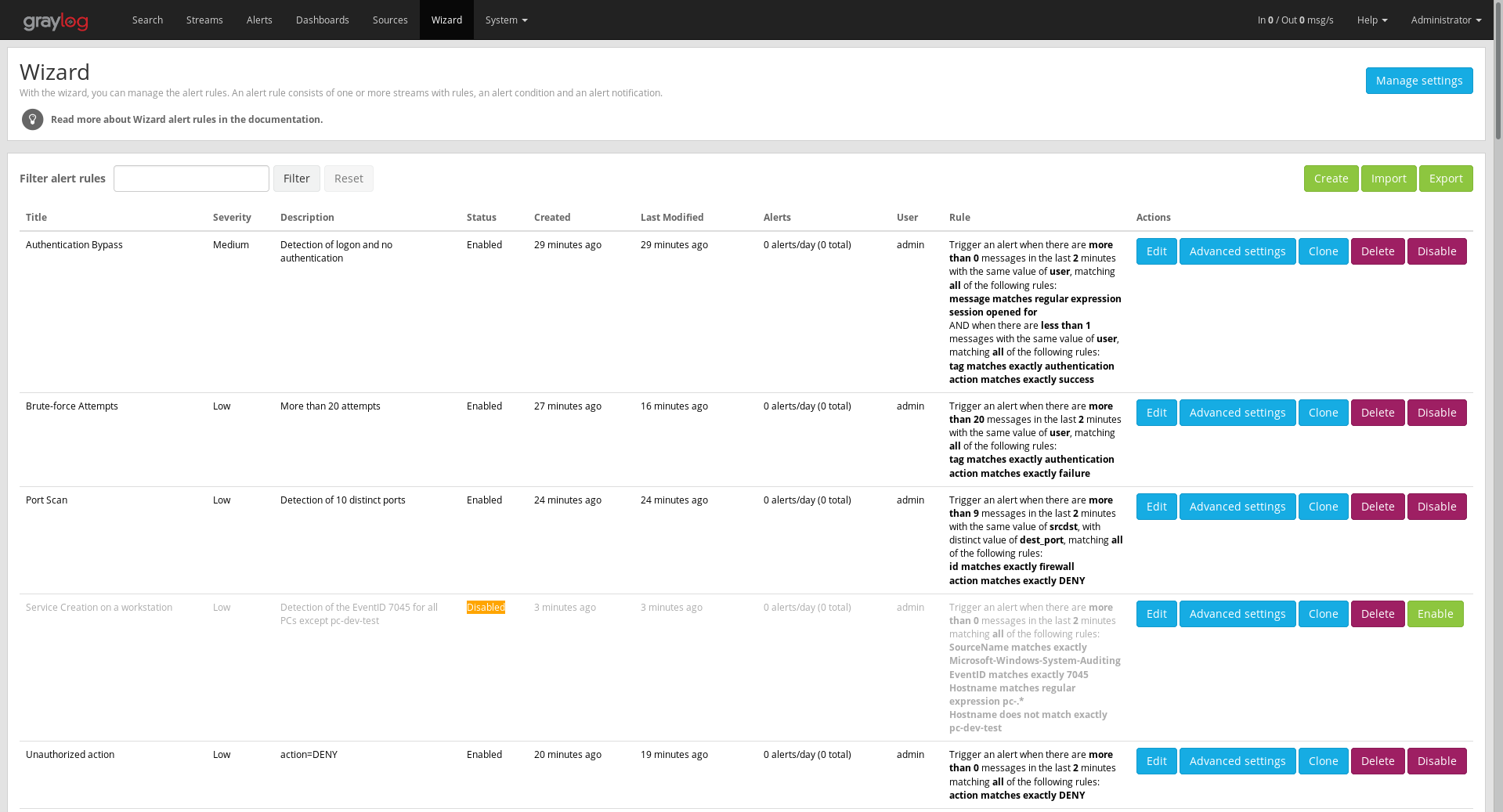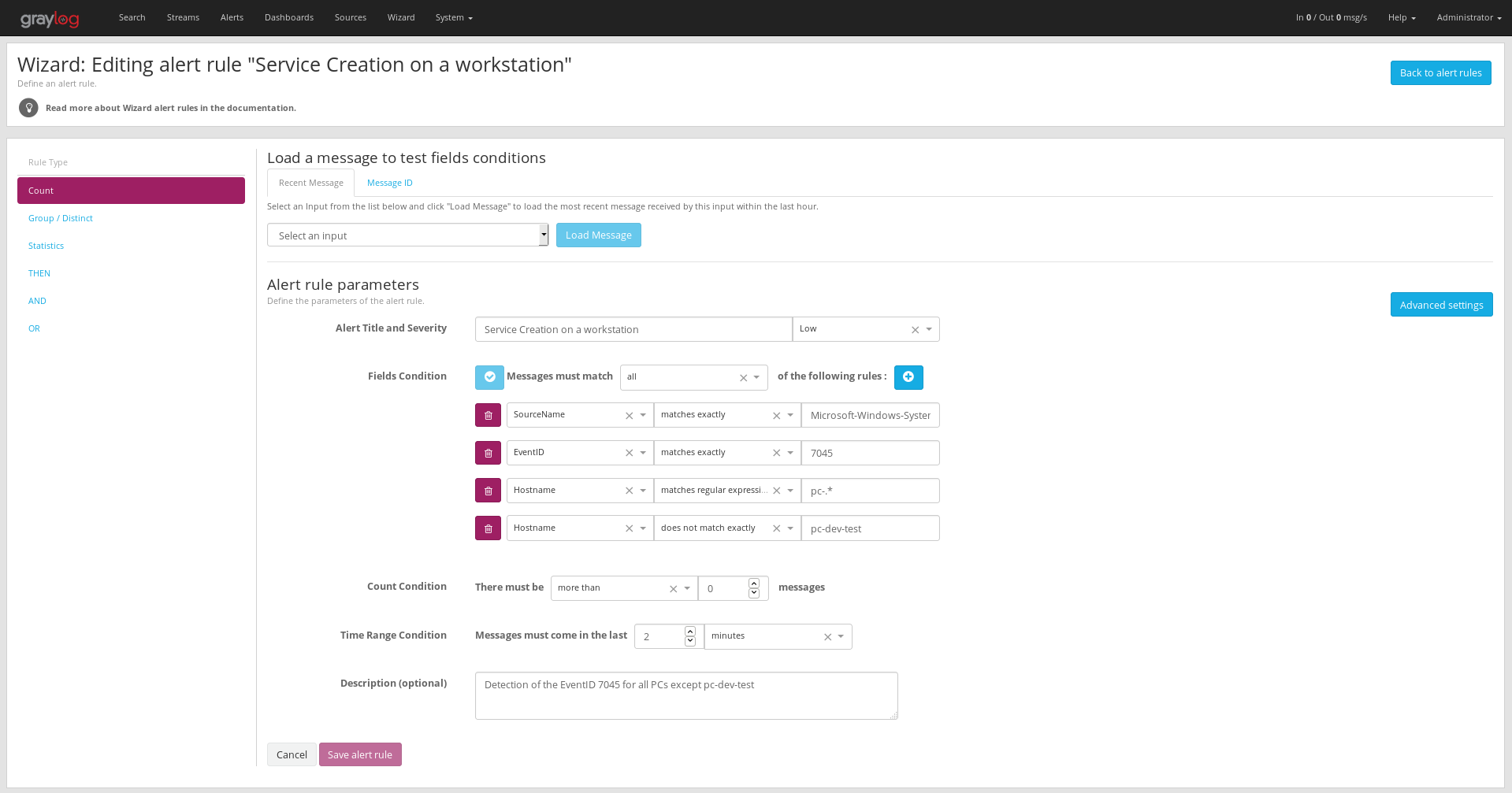An alert wizard for configuring alert rules on Graylog.
Perfect for example to configure together and at the same time a stream, an alert condition and a logging alert notification.
Required Graylog version: see compatibility table below for required version
Packaged Graylog plugins:
| Wizard Plugin Version | Graylog Version |
|---|---|
| 5.2.x | 5.1.x (>=5.1.13) |
| 5.1.x | 5.1.x |
| 5.0.x | 5.0.x |
| 4.5.x | 4.3.x |
| 4.4.x | 4.3.x |
| 4.3.x | 4.2.x |
| 4.2.x | 4.2.x |
| 4.1.x | 4.2.x |
| 4.0.x | 4.1.x |
| 3.3.x | 3.3.x |
| 3.2.x | 3.2.x |
| 3.1.x | 3.0.x |
| 3.0.x | 3.0.x |
| 2.0.x | 2.5.x |
| 1.1.x | 2.5.x |
| 1.0.0 | 2.4.x |
The 'search query' parameter of alert rules has been added. The following migration procedure must be followed:
- Export rules from the preceding version,
- Delete all rules,
- Install version 5.x.x,
- Import rules.
The internal representation of alert rules has been drastically changed. The following migration procedure must be followed:
- Export rules from the preceding version,
- Delete all rules,
- Install version 5.2.0,
- Import rules.
Column Alerts on the page displaying rules. This field should be removed from the configuration.
When updating from a previous version, this field should be removed from the configuration. This can be done with the REST API
(plugins/com.airbus_cyber_security.graylog.wizard/config endpoint)
To give a concrete example, for the following configuration, entry { "enabled": true, "name": "Alerts" }, should be removed from the field_order values.
{
"default_values": {
"severity": "info",
"matching_type": "AND",
"threshold_type": ">",
"threshold": 0,
"time": 1,
"time_type": 1,
"grace": 1,
"backlog": 500,
"title": ""
},
"field_order": [
{ "enabled": true, "name": "Severity" },
{ "enabled": true, "name": "Description" },
{ "enabled": true, "name": "Created" },
{ "enabled": true, "name": "Last Modified" },
{ "enabled": true, "name": "User" },
- { "enabled": true, "name": "Alerts" },
{ "enabled": true, "name": "Status" },
{ "enabled": false, "name": "Rule" }
],
"import_policy": "DONOTHING"
}The alert rule description field is now mapped to the Event Definition description field. To avoid losing the content of the description field when upgrading, you may follow the migration procedure:
- Export rules from the preceding version,
- Delete all rules,
- Install version 4.5.0,
- Import rules.
Alternatively, for each alert rule, you may, before the upgrade, set the description field of its corresponding Event Definition with the value of the rule's description. This may be done manually or automatically via the REST API.
Follow the migration procedure:
- Export rules and lists from the preceding version,
- Delete all rules and lists,
- Install version 4.3.0,
- Import rules and lists. Group/Distinct conditions now accept at most only one distinct field. During import of rules, only the first distinct field will be kept.
WARNING: The REST API for rules has changed. See the README.
Possible issues to Import alert rules from version 3.0.0 or 3.1.0:
- The field "grace" (Now display in Graylog and the Wizard as "Execute search every") have to be strictly greater than 0
- The Log Body of the notification will not be imported, the default one in the general configuration of the plugin Logging Alert will be use, and have to follow the Notification format (Same as the Email Notification)
WARNING: The REST API for the Wizard Configuration has changed.
WARNING: With Wizard plugin in version 2.0.0 and higher you can't import alert rules that have been exported from version 1.X.X.
Upgrading notice:
- Import your alert rules from version 1.X.X
- Upgrade to version 2.0.0
- Export your alert rules in the new format
Download the plugin
and place the .jar file in your Graylog plugin directory. The plugin directory
is the plugins/ folder relative from your graylog-server directory by default
and can be configured in your graylog.conf file.
Restart graylog-server and you are done.
WARNING: The first time your create a rule with a list, the Wizard automatically create a lookup with cache and data adapter. But you must manually set up the authorization key with your login:password in base 64 for the data adapter.
The field "Name" should be filled by "Authorization"
The field "Value" should be filled by "Basic" followed by "user:password" in base64 for example "Basic TXlVc2Vy0k15UGFzc3dvcmQK" where TXlVc2Vy0k15UGFzc3dvcmQK is the result of "echo -n 'MyUser:MyPassword'|base64"
Instead of a user and its password you can also use a token. Use the token's value as username and use the word "token" as password. For example if the token's value is supertoken1234567890: "echo -n 'supertoken1234567890:token'|base64"
MyUser must be a user with admin rights
Refer to this Dockerfile to use the correct version of Java and Maven.
- Clone this repository.
- Clone graylog2-server repository next to this repository.
- Build Graylog2-server with
mvn compile -DskipTests=true(in graylog2-server folder) - Run
mvn packageto build a JAR file (in this project folder). - Optional: Run
mvn jdeb:jdebandmvn rpm:rpmto create a DEB and RPM package respectively. - Copy generated JAR file in target directory to your Graylog plugin directory.
- Restart the Graylog.
This plugin is released under version 1 of the Server Side Public License (SSPL).




